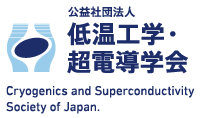Cryogenics and Superconductivity Society of Japan

A Greeting from the President

The mission of the Cryogenics and Superconductivity Society of Japan (CSSJ) is to advance cryogenic and superconductivity-related science and technology, in order to benefit society. The CSSJ evolved out of the Cryogenic Association of Japan, which was established in 1966. After the Cryogenic Association of Japan was founded, it grew and developed steadily, and in 2011, exactly 100 years after the discovery of superconductivity, it was renamed the CSSJ, representing a new start in its evolution. This year (2016) marks the 50th anniversary of the founding of the Cryogenic Association of Japan.
Superconductivity, which enables the flow of large currents with an electrical resistance of zero, has enormous untapped potential, and is expected to become even more important in the future. For example, coils manufactured by winding wires made of a superconductor can be used to generate very powerful magnetic fields without consuming any electricity. Such superconducting magnets are already used in, e.g., magnetic resonance imaging (MRI) devices for medical diagnostic purposes. In addition, superconducting magnets are key elements of JR-Central's Linear Chuo Shinkansen (bullet train), which is currently under construction. However, since superconductivity is a phenomenon that occurs only at extremely low temperatures, powerful refrigerating devices are needed to keep the magnets at cryogenic temperatures. Thus, superconductivity applications can only be practically implemented by combining superconductor technology and refrigeration technology. In addition to considering these technologies as a whole, another important role of the CSSJ is to advance the basic sciences that underlie these technologies, in order to utilize them effectively.
To make use of the latent power of superconductivity science and technology for the benefit of society, we have formulated seven important fields of activity (action indicators), as outlined below. These fields are all deeply connected with human life and future science and technology. Through scientific and technological advancement in these seven fields, to help realize a healthier and happier life for people everywhere, the CSSJ looks forward to continued collaboration with academic societies, researchers, and engineers all over the world.
Shirabe Akita
President of Cryogenics and Superconductivity Society of Japan
Outline of CSSJ
- Cryogenics and Superconductivity Society of Japan (CSSJ) was established as a public interest incorporated association on April 1, 2011. The previous organization of CSSJ has been Cryogenic Association of Japan established in 1966, through the informal meeting for Cryogenic Engineering started on 1961.
- CSSJ Secretariat is located in Hongo, Bunkyo-ku, Tokyo, Japan.
- CSSJ mission is to provide quality programs, opportunities and information related to cryogenics and superconductivity technologies for communicating among members and non-members in response to community needs.
- We work under the President with nine excellent committees, two study commissions, one institute and three local branches located in Kyushu/Nishi-Nihon, Kansai, and Tohoku/Hokkaido.
- We mainly intend to publish the journal "Teion Kogaku", hold semi-annual CSSJ conferences, and meet with neighboring countries.
- As a result, we hope CSSJ will be attractive, hopeful and sustainable.
Vision Statement
- To advance cryogenic technologies and superconducting technologies for greater happiness and sustainable prosperity of people, by contributing to the overall advancement of scientific technology.
- To successively contribute to industrial promotion and personnel training in the cryogenics and superconductivity fields.
Five Missions
- To guide the directions for advancement, and play a leading role.
- To advance academic performance.
- To realize and develop the seven innovative domains, and thereby open up new attractive fields.
- To become internationalized.
- To foster personnel properties.
Action Indicators
- Envisioning a roadmap for the creation of cryogenics and superconductivity.
-
Promotion of communication among citizens, societies, and scientists in other fields.
- ① New diagnosis and medical sector for contributing toward healthier and longer lives.
- ② New transportation sector for realizing high-speed, pleasant and energy-saving transportation.
- ③ Creation, supply and usage of power and energy sector for contributing toward resolving energy problems
- ④ Information and telecommunications sector for maintaining advanced information and telecommunications generations.
- ⑤ Environment and space sector for expanding the known realms of human existence.
- ⑥ Basic science and technology sector for opening up new abilities and opportunities for people
- ⑦ Refrigeration and cooling sector for nurturing key technologies for commercial superconducting instruments
- Fostering international communication among countries and individuals, especially in Asia.
- Encouragement of junior scientists′ participation in society activities, coordination, and leadership promotion.

